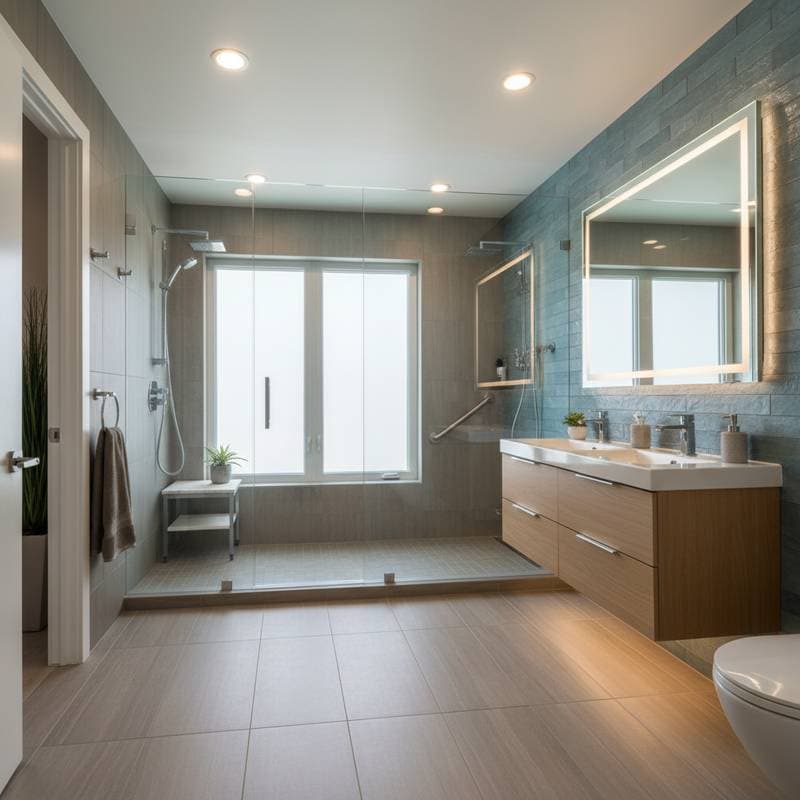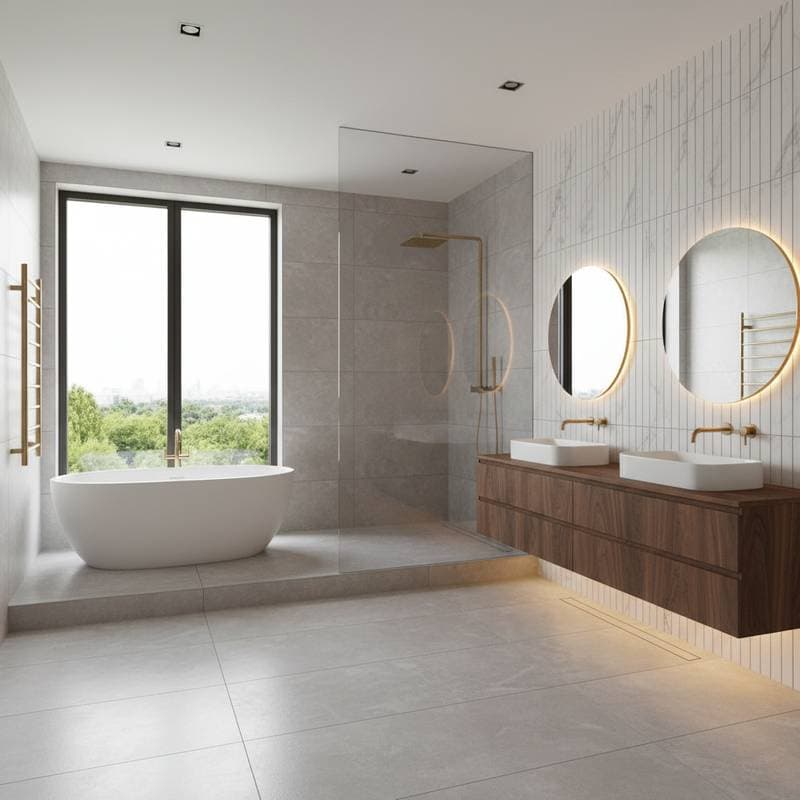Understanding Wet Rooms and Their Appeal
Wet rooms represent a modern evolution in bathroom design, transforming traditional spaces into seamless, waterproof environments without curbs or thresholds. This zero-threshold approach not only enhances visual flow but also improves accessibility for all users, aligning with universal design principles. Homeowners increasingly select wet rooms for their blend of luxury, functionality, and long-term value addition.
The design integrates the shower area directly into the bathroom floor, utilizing specialized drainage and waterproofing to manage water effectively. Such features appeal to buyers seeking low-maintenance, stylish upgrades that evoke high-end spas. As resale markets prioritize adaptable spaces, wet rooms stand out for their ability to broaden appeal across demographics.
Cost Breakdown
Installation costs for wet rooms vary based on materials, size, and complexity, typically spanning $12,000 to $45,000 for a complete project. Factors such as location, existing infrastructure, and custom elements influence the final price. Below, examine key components to budget accurately.
1. Materials
High-quality materials form the foundation of a durable wet room, emphasizing waterproofing and slip resistance.
- Tile and grout: $4 to $15 per square foot for slip-resistant porcelain or natural stone options.
- Glass partitions: Optional additions costing $600 to $1,800, providing enclosure without visual barriers.
- Heated flooring: An enhancement of $1,000 to $2,000 that boosts comfort and accelerates floor drying after use.
Select materials certified for wet environments to ensure longevity and compliance with building standards.
2. Labor
Professional labor proves essential for precise installation, particularly in waterproofing and tiling. Rates generally fall between $70 and $120 per hour, depending on regional norms and project scope.
Intricate layouts, recessed drains, or large-format tiles demand additional time for cutting and leveling. Engage specialists familiar with wet room systems to avoid common pitfalls like uneven slopes or inadequate sealing.
3. Size and Layout
Project scale directly impacts expenses, with smaller configurations offering entry-level pricing.
- A compact wet room of 40 square feet begins at approximately $12,000.
- Expansive luxury setups incorporating bespoke features surpass $40,000.
- Plumbing or drain relocations incur extra charges of $1,500 to $3,000.
Assess your space early to determine feasible dimensions and avoid costly redesigns.
4. Access and Structure
Structural considerations arise, especially in renovations of upper levels or older properties.
Second-floor projects often require subfloor reinforcement and thorough drainage evaluations to handle water loads securely. In vintage homes, subfloor repairs to halt water migration range from $2,000 to $4,000.
Conduct a preliminary inspection to identify potential issues before committing to the build.
5. Permits and Code Compliance
Regulatory adherence ensures safety and avoids future liabilities.
Most areas mandate plumbing permits and inspections focused on drain gradients and waterproof integrity. Fees range from $200 to $800, varying by locality.
Consult local authorities during planning to streamline approvals and prevent delays.
6. Disposal and Demolition
Initial site preparation involves removing outdated fixtures, averaging $500 to $1,200 for tub extraction and tile demolition.
Account for dust management and debris removal, particularly in confined access areas. Proper disposal maintains a clean worksite and complies with environmental guidelines.
7. Add-On Features
Enhancements elevate functionality and aesthetics without excessive cost.
- Built-in niches: $200 to $600 per unit for storage solutions.
- LED lighting: $300 to $900 for ambient illumination.
- Smart thermostats and humidity sensors: $250 to $700 to regulate conditions automatically.
- Ventilation upgrades: $400 to $1,200 to combat moisture buildup effectively.
Prioritize add-ons that align with daily needs and long-term maintenance preferences.
DIY Versus Professional Installation
Deciding between self-installation and hiring experts hinges on skill level and project risks.
DIY Feasibility
Wet rooms necessitate meticulous waterproofing, where even minor flaws invite severe damage.
Attempt DIY only with capabilities in these areas:
- Applying and verifying a seamless waterproof membrane.
- Achieving a uniform drain slope of at least 1/4 inch per foot.
- Employing tile adhesives and grouts designed for submerged conditions.
The primary risk involves a waterproofing lapse triggering $10,000 or greater in repairs from rapid water intrusion.
When to Hire a Professional
Opt for licensed contractors in scenarios such as:
- Subfloor adjustments or plumbing modifications.
- Permit acquisition and inspection processes.
- Natural stone applications requiring specialized sealing and support.
- Integration of underfloor heating within waterproof layers.
Request evidence of insurance and a formal warranty on waterproofing, often extending 5 to 10 years from established providers.
Project Timing and Cost-Saving Strategies
Effective planning minimizes disruptions and controls expenses.
Managing Lead Times
Anticipate delays from custom components like drains and glass panels, which require 2 to 3 weeks for delivery.
Waterproofing applications demand 2 to 4 days of curing prior to tiling. Rushing compromises membrane reliability, leading to premature failures.
Seasonal Considerations
Undertake projects during drier periods, as low humidity aids adhesive curing.
Arrange tile work and installations outside peak holiday seasons when labor availability tightens. Allocate an additional 10 to 15 percent in the budget for surprises in aged structures, such as concealed dampness.
Incentives and Efficiency Measures
Investigate regional rebates for water-saving fixtures or energy-efficient heating systems.
Local conservation initiatives may offset costs on qualifying upgrades, enhancing overall value.
Practical Cost-Reduction Tips
- Retain existing plumbing positions to eliminate relocation fees.
- Select standard tile dimensions to reduce custom fabrication needs.
- Omit floor heating in well-insulated bathrooms.
- Purchase surplus tiles during initial ordering to match future replacements.
These steps preserve quality while optimizing financial outlay.
Enhancing Value Through Market Trends
Wet rooms deliver substantial return on investment, appealing to contemporary buyer preferences.
Their barrier-free design, crisp aesthetics, and resort-inspired ambiance resonate strongly. Additionally, they support aging-in-place objectives by eliminating trip risks from raised edges.
Current Market Analysis
Properties featuring renovated wet rooms typically sell 10 to 15 percent quicker than counterparts with conventional bathrooms.
Valuations rise with documented waterproofing and extended warranties. Industry observers note surging interest in oversized tiles and seamless entries, which amplify perceived space in compact areas.
Accessibility elements like integrated benches and adjustable showerheads widen market reach.
Emerging Design Trends
Current palettes favor subdued shades such as slate gray, beige, and matte white for versatile elegance.
Porcelain mimicking stone textures provides warmth and realism minus intensive care. Concealed drains paired with borderless glass enclosures yield a streamlined, contemporary look.
Subtle lighting beneath benches or in recesses enhances luxury and visibility.
Implementation Guide
Follow this structured approach to execute your wet room project successfully.
Step-by-Step Process
- Examine the subfloor for deterioration or irregularities prior to design finalization.
- Establish a budget with a 15 percent buffer for unforeseen moisture corrections.
- Select a certified contractor with wet room expertise; review prior waterproofing validations and references.
- Finalize material selections promptly to accommodate lead times on tiles and drains.
- Secure necessary permits for plumbing and electrical work before commencing demolition.
- Incorporate ventilation and heating during initial framing to prevent subsequent alterations.
- Verify comprehensive warranty terms for both materials and workmanship.
- Allow complete curing periods post-installation to safeguard finishes from premature wear.
Recommended Enhancements
- Wall-mounted fixtures to maximize floor area and simplify upkeep.
- Recessed LED strips for soft illumination accentuating surface details.
- Retractable benches accommodating diverse users and abilities.
- Multiple showerheads enabling independent flow adjustments.
These options refine usability and elevate the overall experience.
Advancing Your Home Upgrade
Wet rooms offer transformative benefits for daily living and property equity. Obtain estimates from no fewer than three qualified professionals, evaluating waterproofing methodologies alongside aesthetic samples.
Focus selections on safety, ease of care, and enduring style. Prioritize expert waterproofing and drainage systems above all to avert ongoing issues and safeguard structural integrity.











